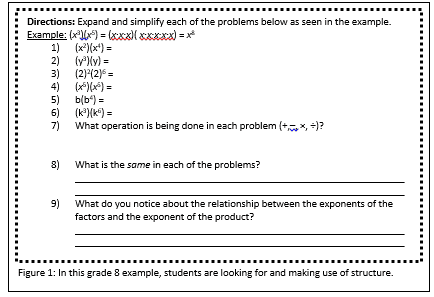I recently asked students to share what they had learned in my math class and how they will use it in the future. I got some of the typical responses that many teachers would expect: students said things like “probability will help me win more money when I’m old enough to go to Vegas” or “parabolas will help on the soccer field when I want to score goals.” Then I had a few that went deeper: “I have learned problem solving skills and how to tackle a problem even if I don’t fully understand it. This will help me in the future with any problem, math related or not, that I may face.” Without fully realizing it, the students who went deeper were identifying pieces of the Standards for Mathematical Practice (SMPs) that they were beginning to master. As math educators we want students to master mathematical content while developing the skills that make them strong mathematical thinkers and problem solvers.
The SMPs outline areas of expertise that mathematics students should strive to master throughout their education. Though the grade-level content will change, the SMPs describe ways in which students should engage with mathematics across all grades. So the question is, as we consider the SMPs, what should we be looking for in aligned instructional materials that will aid in the development of these skills?
The Standards for Mathematical Practice are as follows. You can read more about each one at http://www.corestandards.org/Math/Practice/.
- Math.Practice.MP1 Make sense of problems and persevere in solving them.
- Math.Practice.MP2 Reason abstractly and quantitatively.
- Math.Practice.MP3 Construct viable arguments and critique the reasoning of others.
- Math.Practice.MP4 Model with mathematics.
- Math.Practice.MP5 Use appropriate tools strategically.
- Math.Practice.MP6 Attend to precision.
- Math.Practice.MP7 Look for and make use of structure.
- Math.Practice.MP8 Look for and express regularity in repeated reasoning.
One of the first things we need to realize is that the SMPs are not meant to be stand-alone elements in any set of instructional materials or curriculum. It is important that the SMPs above are embedded within lessons and activities throughout the year. This connection between the SMPs and content is so critical that the SMPs are embedded into the Common Core State Standards. As we look at instructional materials we need to be watchful and look for materials that purposefully connect the SMPs to the content. This should not give you the idea that materials should never explicitly focus on one of the SMPs. For example, you may want to spend time focused on constructing a viable argument and critiquing the reasoning of others. However, this time should still have a meaningful connection to the content standards and should help to further or deepen student understanding of the content.
While it is important to ensure that the SMPs are embedded into the lessons, we must also remember that you should not see, nor is it realistic to see, each of the SMPs in every lesson. Actually, it is not intended for the SMPs to be uniformly distributed over the work that students do. Certain SMPs, like “make sense of problems and persevere in solving them” or “attending to precision,” are overarching practices that we can and should see woven through a large portion of the year. Other SMPs should be seen through the year, but depending on the grade level, some will be seen much more than others as called for in the content standards.
It is also important that materials attend to the full meaning of each of the SMPs. For example, you may find instructional materials that only have students critique the reasoning of others, but never actually construct an argument of their own. Or maybe the materials have students make sense of problems, but never have sufficiently challenging problems where students could learn to persevere in solving problems that take them outside of their comfort zone. Every instance may not fully address each of the SMPs. We are trying to build and teach skills to allow students to develop the mathematical habits that promote critical thinking and mathematical reasoning. However, we should see multiple, meaningful grade-level opportunities for students to attend to the full meaning of the SMPs.
The SMPs provide teachers with an opportunity to help students develop their mathematical reasoning abilities and the habits of mind that will transcend beyond a math class. We should be looking for instructional materials that provide students with opportunities to build those skills and deepen students’ understanding of the content. Within those opportunities we need to see that the materials make meaningful grade-level connections between the content standards and the SMPs and that the SMPs grow in complexity as students gain more knowledge and understanding.


















